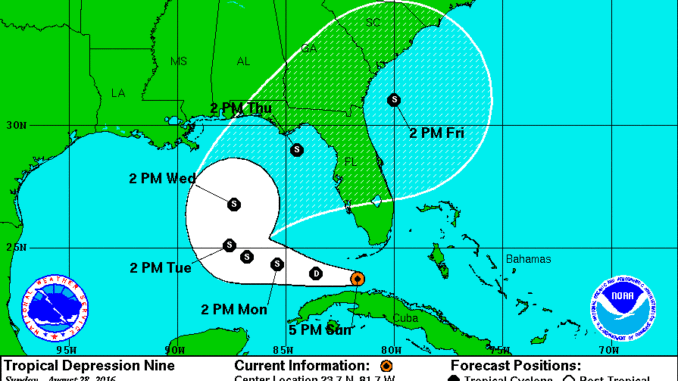
RALEIGH — Governor Pat McCrory is touring farms in Caswell and Columbia N.C. on Sunday morning to learn more about damage caused by Tropical Storm Hermine, which passed through the state on Friday night.
N.C. Emergency Management Director Mike Sprayberry and Agriculture Commissioner Steve Troxler are joining the governor to meet with growers and assess the condition of crops. On Saturday Gov.
McCrory rescinded the State of Emergency declaration effective midnight for 33 counties in eastern North Carolina, with North Carolina having avoided widespread flooding and wind damage.
“I want to thank our emergency management team, National Guard and first responders who ensured our state was prepared to respond to Tropical Storm Hermine,” said Gov. McCrory. “We will be getting a firsthand perspective on the storm’s impact to agriculture on Sunday. I urge beachgoers to continue to be cautious of strong rip currents throughout the holiday weekend.”
N.C. Highway patrol did closed Dare county bridges after strong winds during the storm caused car accidents. One of them, claimed the life of a truck driver when his tractor-trailer overturned on the Alligator River bridge.
The death was the second of two due to Hermine so far. The first was a homeless man in Florida who died when a tree fell on him.
North Carolina Emergency Management Director Mike Sprayberry said what is so far reported to be a tornado in Dare County caused non-life threatening injuries to four people in a campground in Hatteras Village. However, the National Weather Service has not confirmed that it was actually a tornado.
Transportation waivers will remain in effect until midnight Wednesday, September 7 to help utility trucks that are working to restore power and aid with any agricultural operations after the storm.
On Sunday morning Hermine was centered near Ocean City Mayland with 65 mile per hour winds. Officials in the northeastern part of the U.S. are warning residents that the storm is gaining strength and may resume hurricane status winds on Sunday.
The storm is expected to stall off the coast of New Jersey and other major population centers in the Northeast for several days, according to the National Hurricane Center (NHC).
Authorities up and down the coast have ordered swimmers and surfers to stay out of treacherous waters on the holiday weekend when many Americans celebrate the end of summer.
Projections show the outer reaches of the storm could sweep the coastlines of Rhode Island or Massachusetts later in the week as Hermine crawls north and northeast. It was classified as a Category 1 hurricane until it lost strength while cutting across Florida and Georgia, packing sustained winds of up to 65 mph (105 kph).
Forecasters expected winds to return to hurricane force of more than 74 mph (119 kph) by Sunday evening.
“It’s going to sit offshore and it is going to be a tremendous coastal event with a dangerous storm surge and lots of larger waves probably causing significant beach erosion, for the next few days,” said senior hurricane specialist Daniel Brown.
The surge was expected to extend from Virginia to New Jersey. New Jersey Governor Chris Christie declared a state of emergency in three coastal counties of the state, which was devastated by Superstorm Sandy in 2012.
The town of Beach Haven, New Jersey, issued an emergency alert advising anyone planning to leave Long Beach Island, a barrier island that draws summer crowds, to do so before Sunday night’s high tide.
Delaware Governor Jack Markell declared a limited state of emergency for Sussex County, which includes the coastal resorts of Bethany Beach and Rehoboth Beach.
Hermine, the first hurricane to make landfall in Florida in 11 years, swept ashore on Friday near the town of St. Marks with winds of 80 mph (129 kph). It left North Carolina with power outages, flooding, downed trees and power lines, while rain and tides brought flooding along Virginia’s coast.
In the northern Florida town of Ocala, a falling tree killed a homeless man sleeping in his tent.
In North Carolina, a tractor trailer overturned on a bridge over the Alligator River, killing the driver. People posted pictures of flooding and high tides from North Carolina to Delaware.
In Virginia Beach, Virginia, Seth Broudy, 45, owner of the Seth Broudy School of Surf, said high winds and tides flooded parking lots by his home on Saturday. The water and wind receded, but the ocean remained unsafe on Saturday afternoon, he said.
“Right now it’s rough as hell. It’s dangerous,” Broudy said in a telephone interview. “It’s just out of control. It’s like sitting in a washing machine and spinning around.”
Life-threatening storm surges were possible, the hurricane center said. A surge is a rise of water above a predicted tide, pushed by high winds, and is often the greatest threat to life from a storm, according to national weather officials.



